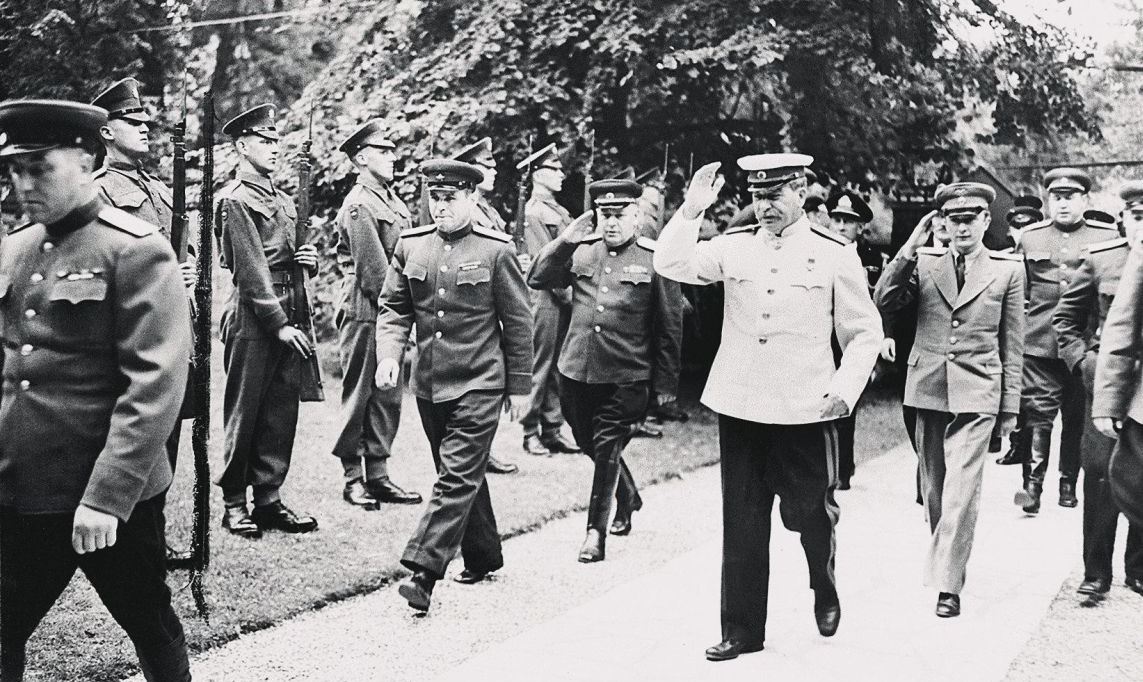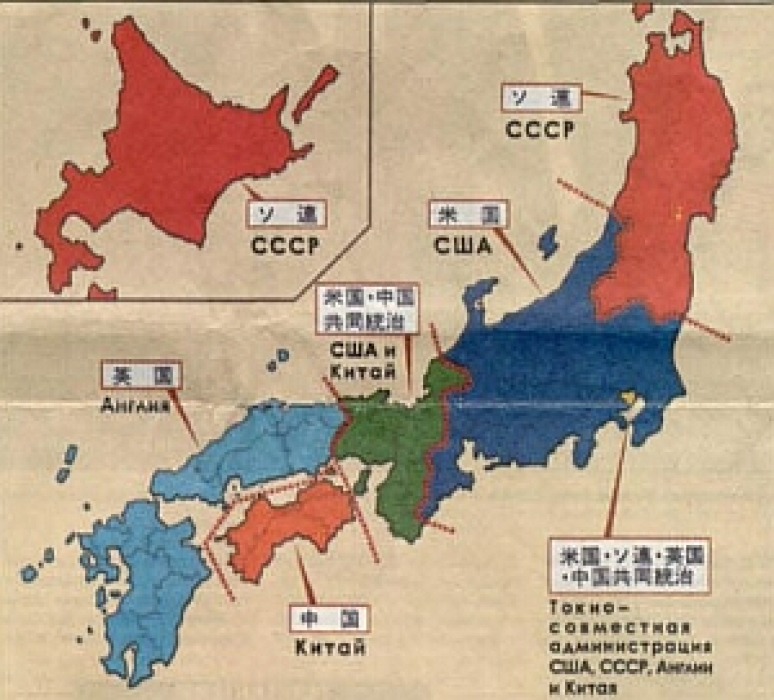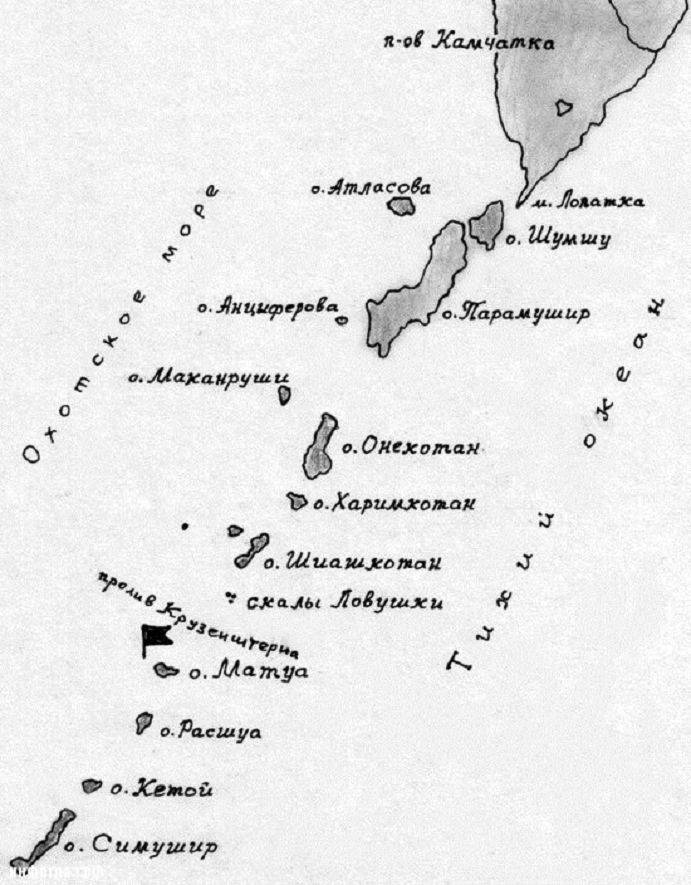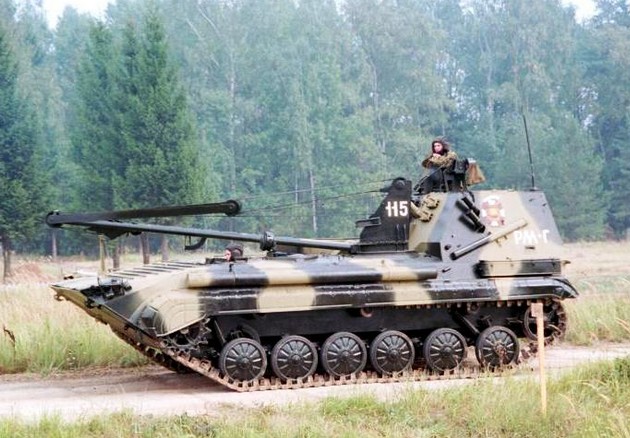
However, Truman did not want to allow the Russians into Japan.

At noon 15 August 1945 year, the Japanese for the first time in the history of the existence of the state heard the voice of their divine monarch, who, in a language difficult for commoners, announced the decision to end the war. As a justification for the impossibility of further resistance, it was pointed out that the Americans used a new superbomb.. It was given to understand, that Japan does not give up, defeated in battle with the enemy, but forced to retreat before an unprecedented weapon. In this regard, there are still people in Japan, who believe, that the use of atomic bombs by the Americans was "tenyu" – by the will of Providence, by the grace of heaven, allowing the holy nation of Yamato to emerge from the war with honor, without losing face.
In reality, the inevitability of defeat, Emperor Hirohito and his entourage was associated not so much with atomic bombings, how many with participation in the war of the Soviet Union. In the rescript from 17 August 1945 Emperor of Japan, without mentioning the American atomic bombs and the destruction of the population of Japanese cities by them, called the entry into the war of the USSR the main reason for the surrender. It was stated: "Now, when the USSR entered the war against us, to continue to resist... is to threaten the very foundation of our Empire's existence.".
Facts show: without the entry of the USSR into the war, the Americans would not have been able to quickly conquer Japan, "throwing it with atomic bombs", as American military propaganda convinced the Japanese population in leaflets and on the radio. According to the calculations of the American headquarters, to ensure the landing of troops on the Japanese islands, it was required, at least, nine atomic bombs. After the attacks on Hiroshima and Nagasaki, the United States no longer had ready atomic bombs.
It should not be forgotten either, that in response to atomic strikes, the Japanese could bring down on their opponents accumulated in huge quantities of bacteriological weapons accumulated in Japanese secret laboratories located in Northeast China. This danger was prevented by the entry into the war of the USSR.
The contribution of the USSR to forcing Japan to surrender was so great, that the Soviet leadership had reason to declare its right to have an occupation zone in the Japanese metropolis.
Directional 15 August 1945 year to Stalin "General Order No. 1" on the surrender of the Japanese armed forces, the US president "forgot" to indicate, that the Japanese garrisons on the Kuril Islands should capitulate to the troops of the USSR. This was the first signal, that the Americans may violate the Yalta agreement on the transition of the Kuriles to the Soviet Union. Stalin responded with restraint, but firmly. He proposed to make the following amendments to "General Order No. 1":
«1. Include all the Kuril Islands in the area of surrender of the Japanese armed forces to the Soviet troops, which, according to the decision of the three powers in the Crimea, should pass into the possession of the Soviet Union.
2. Include the northern half of the island of Hokkaido in the area of surrender of the Japanese armed forces to the Soviet troops, adjacent to the north to the La Perouse Strait, located between Karafuto (Sakhalin. — A.K.) and Hokkaido. Draw a demarcation line between the northern and southern half of the island of Hokkaido along the line, running from the city of Kushiro on the east coast of the island to the city of Rumoi on the west coast of the island, with the inclusion of these cities in the northern half of the island ".
"This last sentence is of particular importance for Russian public opinion.. As is known, the Japanese in 1919-1921 kept the entire Soviet Far East under the occupation of their troops. Russian public opinion would be seriously offended, if the Russian troops did not have an area of occupation in any part of Japanese proper territory", – Stalin wrote.
He called his additions to General Order No. 1 modest and expressed hope, that they will not meet with objections.
Facts and documents testify: initially, the idea of occupying the Japanese metropolis by Soviet troops did not belong to Stalin, and the military-political leadership of the United States. AT 1944 year in Washington, a plan was developed, according to which Japan was to be divided into four occupation zones: American (central regions of the country), Soviet (Hokkaido and Northeast Honshu), English (Kyushu) and Chinese (Sikoku). In terms of area, the Soviet zone even surpassed the American one.. It was believed, that the division of Japan into zones would ease the burden of organizing the occupation regime and allow the United States to reduce the number of American troops intended for this.

Plan of the American Joint Chiefs of Staff (OKNSH) during the first three months after the surrender of Japan, it was planned to allocate for the implementation of the occupation 23 US divisions (800 thousands of people). Then it was planned to deploy the following forces of the allied states on the territory of Japan: US - 8,3 division (315 thousands of people), United Kingdom - 5 divisions (165 thousand), China — 4 division (130 thousand), USSR — 6 divisions (210 thousand).
Why did the American plan of occupation provide for such a significant deployment of Soviet troops in defeated Japan in terms of the number and territory occupied?? Needs to be made clear: the developers of the plan were not guided by the recognition of the contribution of the USSR to the defeat of the Japanese aggressor. Their "generosity" was explained by the desire to use the Soviet troops as "cannon fodder" in case, if a guerrilla war broke out in Japan.
Any documentary evidence of, what Stalin knew about such a plan, failed to find. Not in Yalta, neither in Potsdam the question of the occupation of the territory of the Japanese metropolis by Soviet troops was raised. It is only known, what, in an effort to avoid inconsistency in the conduct of operations, Soviet leader 28 May 1945 of the year, in a conversation with the envoy of the American president, Harry Hopkins, expressed the desire to conclude a special agreement with the governments of the United States and Great Britain on determining the areas of occupation of Japan after the victory over it. The areas of Northeast China and the northern part of the Korean Peninsula were subsequently determined as the zone of responsibility of the USSR in the defeat of militaristic Japan.. Nevertheless, preparing to participate in military operations against Japanese troops, the Soviet command had, among others, a plan for a possible landing on the northern coast of Hokkaido.
However, Stalin's proposal to land Soviet troops on Hokkaido was categorically rejected without any explanation.. Truman replied, that the commander of the allied forces in the Far East, General Douglas MacArthur, surrenders the Japanese armed forces on all the islands of Japan proper, and he "will use token allied military forces, that, of course, will include the Soviet armed forces". In his memoirs, Truman was frank: “Although at first I fervently wanted to involve the USSR in the war with Japan, then, based on the difficult experience of Potsdam, strengthened his opinion not to allow the Soviet Union to take part in the administration of Japan. In my heart I decided, that after the victory over Japan, all power in this country will be transferred to General MacArthur ".
Nevertheless, bound by the Yalta Agreement, Truman was forced to agree "include all the Kuril Islands in the area, who must capitulate to the Commander-in-Chief of the Soviet Armed Forces in the Far East". At the same time, he unexpectedly expressed on behalf of the American government the desire “to have the rights to air bases for land and sea aircraft on one of the Kuril Islands, preferably in the central group". According to some sources, Truman wanted to have the island of Matua turned by the Japanese into a powerful stronghold, where now, as announced, the naval base of the Pacific Fleet of the Russian Federation will be created.

Stung by the refusal of a request to carry out a symbolic landing of the Soviet contingent on Hokkaido, Stalin responded sharply: “Demands of this kind are usually presented either to the defeated state, or such an allied state, which itself is not able to protect one or another part of its territory”.
This made it clear, that, in accordance with the Yalta Agreement, the USSR has the right to dispose of all the Kuril Islands at its discretion.
(To be continued)
Anatoly Koshkin











